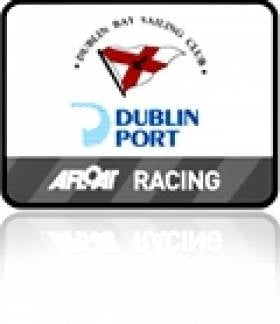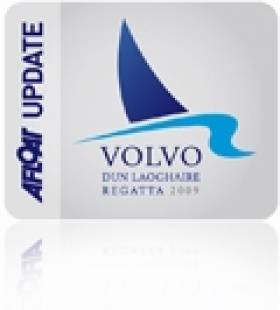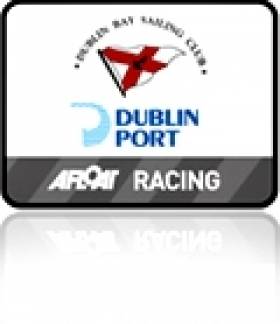Displaying items by tag: 31.7
Supernova to Contest MGM Sponsored DBSC Cruiser Challenge
July's Volvo Dun Laoghaire Regatta Boat of the week, Supernova, will be in action again this weekend in the Cruisers III East Coast championships. The annual fixture is being raced as part of tomorrow's DBSC Cruiser Challenge sponsored by MGM boats, Dún Laoghaire.
Entries for the Challenge stand at 70 to date and remain open for the three day event run by Dublin Bay Sailing Club.
The DBSC Cruiser Challenge is open to Cruisers 0, 1, 2 and 3, Sigma 33s and 31.7s, who will also compete for their national championships during the event.

VDLR Champion Supernova is in action again on Dublin Bay tomorrow
Pat Shannon, vice-commodore of DBSC, says that as well as boats from the main Dún Laoghaire waterfront clubs, DBSC has invited boats from Howth, England and the Isle of Man to compete. "Last year we had 80 boats and we expect something similar. We're running it over the UK bank holiday so we might get those boats," says Pat. DBSC also welcomes Cruisers 3 to the event, who are taking part for the first time. (The Cruiser Challenge will also incorporate this year's Cruisers 3 East Coast Championships.)
This year the National Yacht Club is the host club for the event. Hal Bleakley is the race officer on committee boat, MacLir, and Henry Leonard is race officer on Spirit Of The Irish. NYC sailing manager Olivier Prouvier will coordinate activities on the water.
The organisers also plan plenty of fun after racing, with live music and barbecues in the NYC and a party for the 31.7 nationals in the National Yacht Club on Saturday night.
The main organisers are DBSC commodore Tony Fox, vice-commodore Pat Shannon, rear-commodore Chris Moore and honorary secretary Donal O'Sullivan, assisted by a team of around 28 volunteers. "We're always very grateful to the volunteers, they're the greatest resource we have," says Pat. "We have all the equipment, the greatest resource is the people who help out."
Pat adds that there are great prizes this year – half model yachts, made by Marine Model Makers of Wicklow. "They are very special, so it's worth entering," he says.
The entry fee for each boat is €105 with a reduced fee of €80 for entries received before 12th August.
Post-DL Regatta Event for Ultimate Bragging Rights
Competitors in this year's Volvo Dun Laoghaire Regatta are set to race for the ultimate bragging rights in a new bonus event.
The Royal Irish Yacht Club is proposing the one-day event on Sunday 31 July modelled on the ISA All Ireland Sailing Championship, where up to 16 teams will compete in a winner-takes-all contest with the prize of a significant voucher to go against their annual Dublin Bay Sailing Club subscription.
The best helms from Cruisers 1, 2 and 3, White Sails, Sigmas, Dragons, 31.7s and SB3s will compete using the symmetrical kite J80s in a round-robin fleet racing format.
Each participating DBSC class will have one team, selected by being the highest ranked DBSC boat in the Dun Laoghaire Regatta. Each class can decide if the team is chosen on a design, IRC or ECHO basis.
More details will be available in due course from the RIYC website.
Dublin Bay Sailing Club's annual Cruiser Challenge for Cruisers 0, 1, 2, Sigma 33 and 31.7’s will be held from 26th-28th August 2011. This year the sailing weekend event is hosted by Dun Laoghaire's National Yacht Club. The notice of race for the event is below:
The Cruiser Challenge 2011
26th-28th August 2011
PROVISONAL NOTICE OF RACE
1. Organising Authority and Rules
The organising authority is Dublin Bay Sailing Club. The event is governed by the Racing Rules of Sailing and any amendments thereto, IRC, the ECHO handicapping system rules, Sigma 33 class rules, the 31.7 Class Rules, this Notice of Race and the sailing instructions. In the event of a conflict the sailing instructions shall prevail.
2. Schedule of Races
Warning Signals
Race 1 26th August 16:55 hrs. Fixed mark course.
Race 2 27th August 10:45 hrs. Windward/Leeward or Trapezoid type course.
Race 3 ASAP after Race 2 Windward/Leeward or Trapezoid type course
Race 4 28th August 10:45 hrs Windward/Leeward or Trapezoid type course
Race 5 ASAP after Race 4 Fixed mark course
Note: Any of the above courses may be substituted for each other or a course as announced on VHF Channel 74.
3. Racing Area
The racing area will be the waters of Dublin Bay and Killiney Bay - Admiralty Chart 1468.
4. Eligibility
Eligible boats are those the classes which comply with the relevant handicapping system, the one design Sigma 33 rules, the 31.7 class rules and the entry requirements.
5. Classes and Handicap Systems
5.1 Boats will race under IRC, ECHO Handicap System, Sigma 33s and 31.7 classes will race one design and under ECHO.
5.2 Cruisers will be divided on the basis of their current ISA Standard ECHO Reference Handicap/ IRC
ECHO Handicap as follows:
Cruisers 0 - Boats at 1.045 to 1.250
Cruisers 1- Boats at 0.980 to 1.044
Cruisers 2- Boats from 0.920 to 0.979
5.3 Boats shall comply with all stipulations and/or conditions relevant to the valid current certificate. (Subject to the right of the organizing authority to allocate a boat to any class.
6. Team Event
A trophy will be presented to the entered team comprised of one boat from each cruiser class, the Sigma33 class and 31.7 class which aggregates the lowest number of points over the series of races under IRC, one design for the Sigma class and 31.7class. Teams should be nominated in writing to the Race Office before commencement of racing. Note: RRS Appendix D (Team Racing Rules) shall not apply.
7. Certificates
ECHO handicaps will be advised to DBSC by the relevant rating authority. A copy of the relevant IRC certificate must accompany the entry form. However, it is the entrant's responsibility to ensure that DBSC have the correct handicap available and therefore late changes should be advised to the Hon. Secretary by the boats concerned.
8. Responsibility
8.1 The safety of a boat and her crew is the sole and inescapable responsibility of the owner(s) or the owner’s representative whose obligation it is to ensure that the boat is fully sound, seaworthy, manned by an experienced crew and equipped with all the necessary safety gear. Neither this Notice of Race or the Sailing Instructions nor any action of the organizing authority in any way limits or reduces the complete and unlimited responsibility of the owner(s) or owner’s representative.
8.2 Attention is drawn to RRS Fundamental Rule 3 “Acceptance of Rules” and Rule 4 “Decision to race”.
8.3 Boat owners and competing crews shall ensure that they are adequately insured against loss, damage or injury to persons, boats or equipment at all times and however occurring and shall maintain third party insurance cover of not less than one million five thousand EURO (€1,500,000), and shall produce a valid certificate of insurance upon request.
8.4 No responsibility shall be accepted by the organizing authority, its members, servants or agents, nor those officials or members connected with the event for any loss, damage, injury or other claim of whatever nature howsoever arising or caused in connection with participation in, or intended participation in this event.
9. Entries
The entry fee for each boat is €80.00 Entries shall be made by completing the details on the boat entry form (overleaf) and forwarding it to the Hon. Secretary, D.P.O'Sullivan, 72, Clonkeen Drive, Foxrock, Dublin 18. (The form may also be downloaded from the DBSC website). An entry is required from all boats intending to compete, including those already racing in a current DBSC series. The latest date for entries is Monday 22nd rd August. Late entries may be accepted at the discretion of the Committee and on payment of late entry fee of €25.00
Helmsmen and their crews competing in the event will be temporary members of DBSC and the National Yacht Club for the days of the event. Owners, Helmsmen and their crews will be bound by the rules of the Clubs. The Clubs reserve the right to withdraw such temporary membership. All entries are accepted at the sole discretion of the Committee.
10. Sailing Instructions (May be available www.dbsc.org during August 2011)
Sailing Instructions may be posted to each entrant, left in entrant’s yacht club or collected from the Race Office before racing. Please indicate on the entry form whether Sailing Instructions are to be posted or to be collected. The Race Office and official notice board will be situated in the National Yacht Club.
11. Berthing
Boats requiring berths on the Marina must register with the Marina Administration Office on Ch. 37A prior to being advised which berth they will be allocated. Overnight berthing is available at normal rates. Berths will be allocated on first come basis. Marina Tel. (01) 2020040./ Fax (01)2020043.
A limited number of berths may be made available at the National Yacht Club. Please contact the boathouse prior to arrival.































































